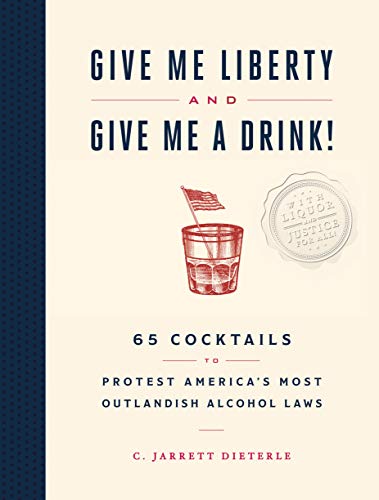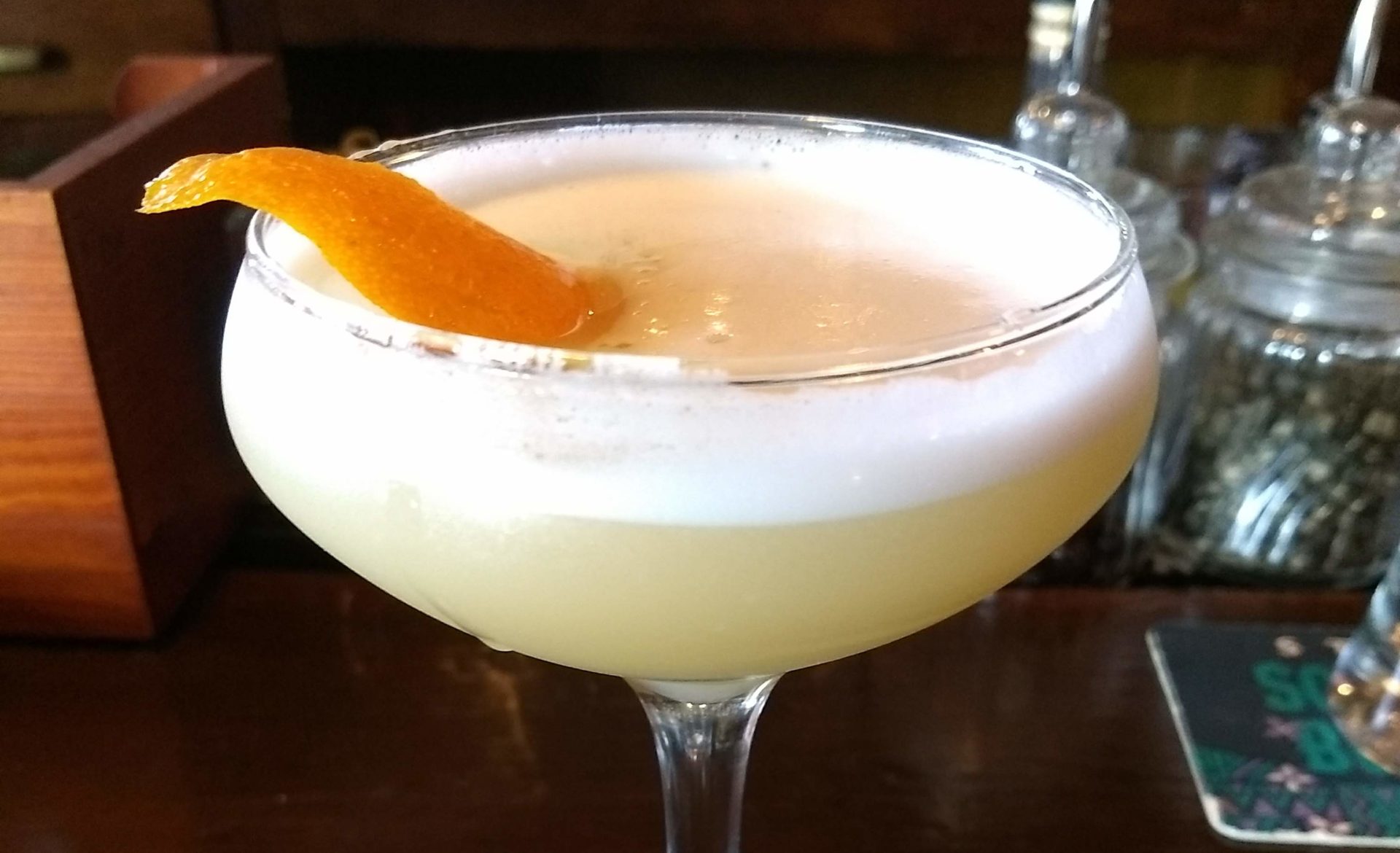
The other week, I spoke live with Jarrett Dieterle about his new book, Give Me Liberty and Give me a Drink!
What follows below is a transcript of our conversation, edited and shortened for your reading ease.
AlcoholReviews.com: So you’ve written a book about drinks policies–really bad drinks policies. Why?
Jarrett Dieterle: The reason is simple. When I started studying alcohol policy, I naturally began meeting people who worked in the industry—bartenders, brewers, distillers. I started talking to them to learn what they were dealing with and what their day to day life was like. It was stunning to hear about the kind of arcane, antiquated laws they were dealing with—laws which would be totally unheard of in other sectors or industries—and how few people outside the industry were aware of their struggle.
The more that I talked to industry stakeholders, the more I realized that this wasn’t a one state problem, it was a 50 state problem. Every state had an outdated system that hurt consumers, producers, and retailers of alcohol. That got me to thinking: Someone should write a book about this. And since the topic is alcohol, it naturally made sense to have a little fun with it and also include cocktail recipes inspired by some of these bizarre laws!
AlcoholReviews.com: A century ago a lot of Western nations enacted Prohibition. Today, we’re seeing Prohibition being imposed in nations in Asia and Africa. Why does Prohibition not work?
Jarrett: You’re right, Prohibition hasn’t fully gone away. We’ve even seen versions of it closer to home recently when Mexico halted beer production during COVID-19. It doesn’t work because anytime throughout history when governments have raised the barriers for accessing alcohol too high, human’s innate desire for hooch has stubbornly remained. So instead of being able to simply obtain legal alcohol, we humans have turned to illegal alcohol. Which is why anytime a form of Prohibition has been enacted, a robust black market has almost immediately sprung up.
Unsurprisingly, these black markets produce an inferior product that is less safe to consume. Illegal moonshiners often work in unsanitary conditions and there’s little accountability for producing or selling a bad batch of hooch. So ultimately it creates a public health issue. This may seem like a remote concern in modern day America, but consider what Pennsylvania did during COVID. They closed all their government-operated liquor stores, which caused Pennsylvania residents to flood across state lines to neighboring states to obtain spirits—all of which was less safe since they ideally should not have been traveling in the midst of a pandemic.
AlcoholReviews.com: One surprising thing you note your book is that Prohibition had a negative effect on Apple growing in America, which is not something I think a lot of people know about. Can you tell us a bit about that?
Jarrett: Sure, that’s an interesting one. One of the main things Prohibition did was really hurt drinks culture in America. Before Prohibition, in what was called the Golden Age of Cocktails, there were brilliant bartenders using fresh ingredients and making cutting-edge drinks. American cocktails were in fact the envy of the world at that time. Then Prohibition happened, and all that was lost. Bartenders suddenly found themselves out of work and they were forced to either drop out of the business altogether or move abroad.
And in a less obvious way, the same thing happened with the humble apple. You see, many early Americans—especially in rural areas—grew apple orchards. They did this because they wanted to produce hard cider, which at the time was one of the most popular alcohol beverage choices in America. As a result, our country’s apple crop, like our cocktail culture, was the envy of the world—we had more apple species than any other country. But once Prohibition hits, the feds grew increasingly desperate to cut off any and all potential sources of booze. And that included apple orchards that could produce cider. So axe-wielding federal agents literally chopped down tens-of-thousands of acres of apple orchards during Prohibition.
The result was that our rich apple heritage was decimated and it still hasn’t fully recovered to this day (it’s one reason why modern apples at grocery stores are so uniform and often tasteless).
AlcoholReviews.com: Prohibition was repealed nearly a century ago, but as your book details, its spirit lives on in many public policies. As I read through your book, I was reminded of how
almost Soviet-sounding some of these policies are. Your book references a law in a town in Alaska—can you tell us about that example?
Jarrett: Yes, that’s Bethel, Alaska, which is a small town up there. They attempt to control the amount of alcohol that their residents can possess at any one time. You can’t have more than 10.5 liters of distilled spirits, 24 liters of wine, or 12 gallons of beer, and the government has apparently created a database to track how much booze each resident has ordered.
It’s an interesting situation because it a shows the power of local governments. We so often focus on state-level laws regarding alcohol—my book included—but local laws can be equally draconian. That’s also why you still see things like dry counties in American where you can’t purchase or transport any alcohol. While these laws still exist in many places, there’s a broad swath of Americans that probably have never heard about them. And I think most of them would be shocked, frankly, at how creepy and paternalistic are alcohol laws can really be.
AlcoholReviews.com: Ok, well creepiness aside and paternalism aside, your book also demonstrates that a lot of booze laws are either cronyist or just sort of silly. Tell us about one cronyist law and one silly law.
Jarrett: Oftentimes cronyism and silliness go hand-in-hand when it comes to alcohol. Take Indiana’s infamous warm beer law. The state actually prohibits gas stations and convenience stores from selling cold beer. They can sell room temperature beer, but they cannot pop it in the cooler or put it on ice. But liquor stores in the state, which operate under a different license, are allowed to sell cold beer.
So this law is very silly, but why does it exist? Well, cronyism. Unsurprisingly, the liquor stores like being the only game in town when it comes to selling cold beer. Which means they’re not about to give up that privilege without a fight. Accordingly, they exert a lot of lobby power in the state legislature to keep this law in place.
AlcoholReviews.com: Your book talks quite a bit about so-called control states where the government is in charge of all alcohol sales. Can you tell us a bit more about the drawbacks of the control state system?
Jarrett: When it comes to outdated alcohol laws, control states would be near the very top of the list in terms of the harm they cause. Being a control state means that the government controls either the wholesale level or the retail level of spirits sales within that state—or sometimes both. Unlike pretty much every other industry in our modern economy, the government in these situations is acting like a private retailer and market participant.
This causes a whole host of unintended consequences. In control states, producers have to jump through a whole ton of hoops to get their products accepted by the state retail stores. Sometimes the states are very receptive to local spirits and other times they are less so. It’s usually a government committee that’s deciding which distilled spirits are carried in state stores, and if a spirit doesn’t get accepted, then it’s effectively locked out of the retailing market in its own state. It shows the kind of the stakes that are at play with some of these laws.
AlcoholReview.com: Let’s switch over to a more cheerful subject. Where did you get all these cocktail recipes for the book?
Jarrett: That was definitely the fun part. A lot of them are my own riffs on famous drinks. Others are ones I came up with after a lot of experimenting. As I’ve grown more interested in drinks culture, history, and policy over the years, I’ve naturally learned a lot and have developed an interest in cocktail ingredients.
I got a lot of recipe ideas from bartenders I admire, and I also get a few from family members or friends. Families can be a secret treasure trove of cocktail recipes, as nearly everyone knows an uncle or a family friend who makes a mean Bloody Mary or a famous holiday eggnog that you can tweak to make your own. I try to connect the cocktails in the book to each law I feature. So in Washington State, for example, where distilleries are only allowed to sell 2 ounce of their spirits per day to costumers, the cocktail recipe calls for 1.9999 ounces of whiskey.
AlcoholReviews.com: Out of all 65 cocktail recipes in the book, which would you consider your favorite?
Jarrett: That’s like being asked to choose your favorite child! But I do have a good answer: My favorite is my ginger cairpirinha recipe. As many people know, the cairpirinha is the national drink of Brazil and is traditionally a combo of cachaça, limes, and sugar. My wife’s family is Brazilian and they introduced me to the cairpirinha on a trip to Brazil back in the day.
It’s just a simple, wonderful drink that in my view is the quintessential summer libation given its vibrancy and thirst-quenching nature. But I also like drinking all year around, of course, which led me to experiment with ways to make a sort of all-seasons version. By adding a dash of ginger liqueur, as well as some ginger beer, the drink takes on more of a fall/winter vibe given the widespread use of ginger in many holiday recipes. The combo of a meaningful family connection to the drink and the fact that it also tastes delicious makes it an easy pick!
AlcoholReviews.com: Last question. Your book spends a lot of time talking about a lot of bad laws and regulations in this country. Just stepping back, are alcohol laws getting better or worse overall in America? Is there any hope for the future?
Jarrett: It’s funny because if we would have had this conversation in, say, January of this year, I would have said that while there’s been some modest progress, we’re still stuck in a frustrating status quo. But then COVID happened and things suddenly shifted. When the pandemic forced most bars, breweries, and distilleries to temporarily shutter their on-site dining rooms and taprooms, these businesses looked to pivot to delivery or to-go models for their products.
But then reality set in: A lot of jurisdictions still prohibited alcohol delivery or innovations like to-go cocktails. This forced lawmakers, for the first time since Prohibition, to confront in real-time our outdated and backwards system of alcohol regulation. Now, over 30 states have temporarily green-lighted to-go and delivery booze, and numerous states have made these reforms permanent since COVID began. Once you start allowing alcohol delivery—and you get policymakers thinking about how our alcohol system is badly in need of updating—I think you can start to see a path toward a freer marketplace in the years ahead. It will still be a long road, but we finally have the car headed in the right direction and a full tank of gas.

